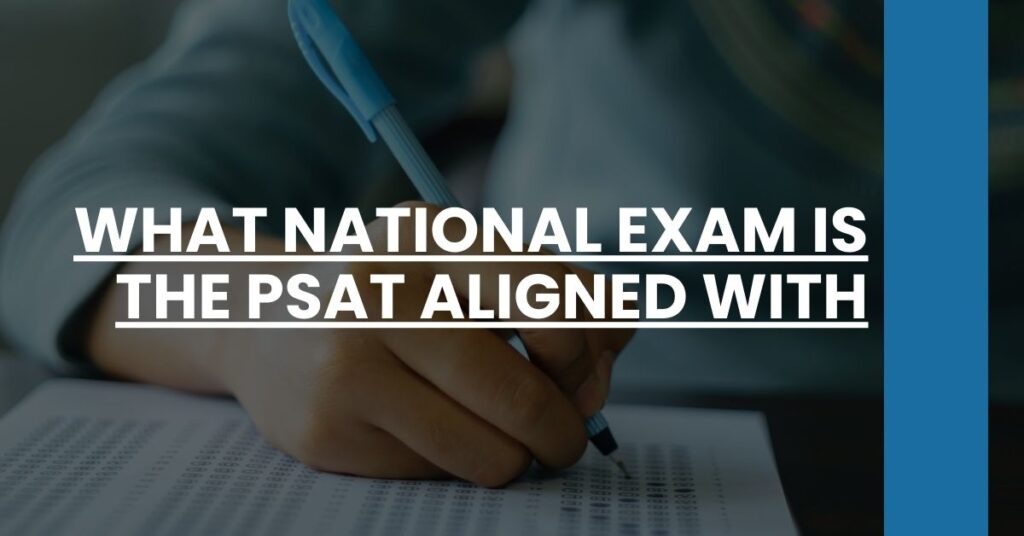The PSAT is aligned with the SAT, a standardized national exam widely used in college admissions. As you navigate your journey towards higher education, understanding this alignment is key.
- The PSAT acts as a preliminary SAT, giving students a preview of the SAT format and content.
- Excelling in the PSAT can lead to National Merit Scholarships and serve as a predictor for SAT performance.
Reading on, you’ll grasp why the PSAT is an essential step in your college readiness plan, providing insights that can bolster your SAT preparedness and open doors to scholarship opportunities.
- Introduction to the PSAT
- The SAT: The Exam Aligned with the PSAT
- Components of the PSAT and Their Correlation to the SAT
- Purpose of the PSAT Alignment with the SAT
- The National Merit Scholarship Program and the PSAT
- The Impact of PSAT Scores on College Admissions and SAT Preparation
- Differences Between the PSAT and SAT
- Preparing for the PSAT and Its Benefits
- Navigating the Transition from PSAT to SAT
- Conclusion: The Role and Value of PSAT Alignment
Introduction to the PSAT
The Preliminary SAT, or PSAT, is much more than just a rehearsal for its more famous sibling. Designed to mirror the structure and content of the SAT, this exam acts as a critical barometer of your readiness for the challenges that await in the actual SAT test environment. Generally taken in your sophomore or junior year of high school, it not only provides a practice run but also throws light on the areas you may need to focus on before the main event.
Recognized as a tool for identifying talented students, the PSAT is often your initial encounter with the pressures and the style of questions that you’ll face in one of the key national exams that ascertain your readiness for college—the SAT. The connection between the two is deliberate, with the PSAT serving as a stepping stone to the broader academic and scholarship opportunities that a robust SAT score can unlock.
The SAT: The Exam Aligned with the PSAT
When you ponder on the question, “what national exam is the PSAT aligned with?”, the direct answer is: the SAT. Standing for Scholastic Assessment Test, the SAT can often feel like the high stakes culmination of your high school efforts, shaping your college admission outcomes.
As its preliminary counterpart, the PSAT presages the testing environment and types of questions you’ll confront on the SAT, making it a beneficial first round before the main competition. While the SAT scores are a significant factor in college admissions, PSAT results can inform you about the areas you might need to improve in. This early insight provides a headstart on refining your test-taking skills, improving your chances of a better SAT performance.
Components of the PSAT and Their Correlation to the SAT
Your PSAT experience is crafted to be as close as possible to the SAT. Both exams include sections on Reading, Writing and Language, and Math, and employ a multiple-choice format. The tests are designed to assess your critical reading skills, command of evidence, understanding of words in context, and your quantitative problem-solving abilities.
Yet, there are distinctions in scoring—while the PSAT is scored on a scale from 320 to 1520, the SAT has a higher upper limit, scoring between 400 and 1600. These differences in scale are reflective of the SAT’s broader scope and more complex material. The PSAT essentially acclimates you to the format and pacing that you’ll need to master for its more demanding counterpart.
Purpose of the PSAT Alignment with the SAT
Why exactly is the PSAT so closely aligned with the SAT? Think of it as strategic preparation with tangible benefits. The alignment helps you, as a student, to become familiar with the types of questions and the timing pressures of the SAT. For educators, it serves as a valuable benchmark for assessing student potential and guiding their instructional focus.
If you’re a high school student, your PSAT scores provide a baseline for predicting how you might perform on the SAT. This prediction, in turn, can serve as motivation, guiding your study plan and boosting your confidence as you sharpen your skills for the more challenging exam ahead.
The National Merit Scholarship Program and the PSAT
A notable feature of the PSAT is its role as the qualifying test for the prestigious National Merit Scholarship Program. Achieving a top score can open the door to significant scholarship opportunities and national recognition. In this context, the PSAT serves as far more than just practice for the SAT; it can be a key that unlocks potential financial support for your college education.
Your performance on the PSAT can put you in the running for the National Merit Scholarship, as well as other scholarships that align with your academic interests and career aspirations. As such, it’s sound strategy to approach the PSAT with the same level of seriousness as the SAT.
The Impact of PSAT Scores on College Admissions and SAT Preparation
Let’s dive deeper into the significance of your PSAT performance. While your scores on the PSAT aren’t directly considered in college admissions decisions, they can be more influential than you might think. For starters, your PSAT scores can signal to colleges your interest in higher education, especially if you opt into College Board’s Student Search Service. This can lead to universities taking an early interest in you, sending you materials, and even tailored scholarship opportunities.
Moreover, your PSAT results can be a wake-up call — a powerful forecast of your future SAT scores. By testing the waters with the PSAT, you lay the groundwork for a robust SAT prep plan that’s aligned with the needs highlighted by your preliminary performance. Think of it as a compass directing your study focus — if you know where you’re starting from, you can better map out the path to where you need to be.
A stellar PSAT score can also make you eligible for scholarship programs beyond the National Merit Scholarship. Colleges and private organizations often scour PSAT results to find potential candidates for financial aid. So buckle down, because your PSAT prep could be just as vital as your SAT studies in the long run.
Differences Between the PSAT and SAT
Understanding “what national exam is the PSAT aligned with” involves recognizing the nuances between the PSAT and the SAT. Fundamentally, both tests assess similar domains of knowledge, but they’re not identical twins. The SAT is a more extensive and detailed exploration of your academic capabilities, reflecting the bigger weight it carries in the college admission process.
Here’s a quick rundown of some distinguishing features:
- Length and Content: The SAT includes an optional essay and more complex questions, reflecting its deeper and broader assessment of student abilities.
- Scoring: With a higher maximum score available, the SAT necessitates more precision and skill to achieve top percentile rankings.
- Stakes: The pressure is undoubtedly higher when you sit for the SAT, as these scores factor significantly into college admissions decisions and merit-based financial aid awards.
A comprehensive comparison between the two exams can be found at Best Colleges’ PSAT vs SAT guide, detailing everything from structure to scoring scales. It’s crucial to tackle both tests with calculated preparation, but with an understanding of the greater demands of the SAT.
Preparing for the PSAT and Its Benefits
Your approach to the PSAT should be strategic. By preparing diligently, not only do you stand a better chance of qualifying for scholarships, but you can also use the process to refine your test-taking skills for the SAT. Here’s a pro tip: incorporate your PSAT prep into a long-term study plan that carries you through to your SAT date.
Consider these strategies for a well-rounded preparation:
- Practice Tests: Full-length practice tests are one of the best ways to get used to the timing and format of the PSAT (and, by extension, the SAT).
- Focused Review: Use your PSAT practice tests to identify weak areas, and tailor your study sessions to bolster these topics.
- Consistent Practice: Regular studying over time typically yields better results than cramming last minute. Stretch your preparation out over several months.
For a useful resource, head over to College Data for reasons to take the PSAT and tips for preparation. Keep in mind that a strong performance here lays a solid foundation for success on the SAT.
Navigating the Transition from PSAT to SAT
The leap from PSAT to SAT is a significant one, but it doesn’t have to be daunting. Proper planning and a keen awareness of the differences between the two tests are your best tools. Take the feedback from your PSAT seriously, and build a study schedule that gives extra attention to areas where you need the most improvement.
Leverage the structure of the PSAT, using it as a template for understanding the SAT. If you’ve identified time management as a challenge, for instance, use timed practice sections to hone your skills. Engage with SAT prep resources — many of which offer tailored lessons and practice exercises — to bridge the gap between the exams. It’s also important to adjust your mindset for the SAT; remember, the stakes are higher, so amp up your study intensity as the SAT date approaches.
In lacking a specific comprehensive resource for this transition, a gap exists for many students. Recognize this, and proactively seek out SAT-specific prep materials to ensure that when you sit down for the SAT, it feels like a familiar challenge, rather than a new frontier.
Conclusion: The Role and Value of PSAT Alignment
In your quest to understand “what national exam is the PSAT aligned with”, remember that the PSAT is more than a practice run for the SAT — it’s a launchpad for academic development and scholarship potential. Its alignment with the SAT provides a structured framework for you to build upon, ensuring that when you take the SAT, you’re as ready as you can be.
The value of this alignment lies in your ability to use the PSAT as a strategic tool. It’s not just about testing the waters, but also about building a sturdy bridge from where you are to where you need to be in your academic journey. So take the PSAT seriously, dissect your results to maximize the benefits, and let this experience guide your pathway to SAT success.
The connection between the PSAT and the SAT exemplifies a deliberate and thoughtful approach to standardized testing that benefits you at every turn, arming you with knowledge, skills, and opportunities. Make the most of it, and you’ll find that aligning your efforts with these national exams paves the way for a bright academic future.

